五年级下册 Unit _2 Our new home_单元整体备课资源
文档属性
| 名称 | 五年级下册 Unit _2 Our new home_单元整体备课资源 | 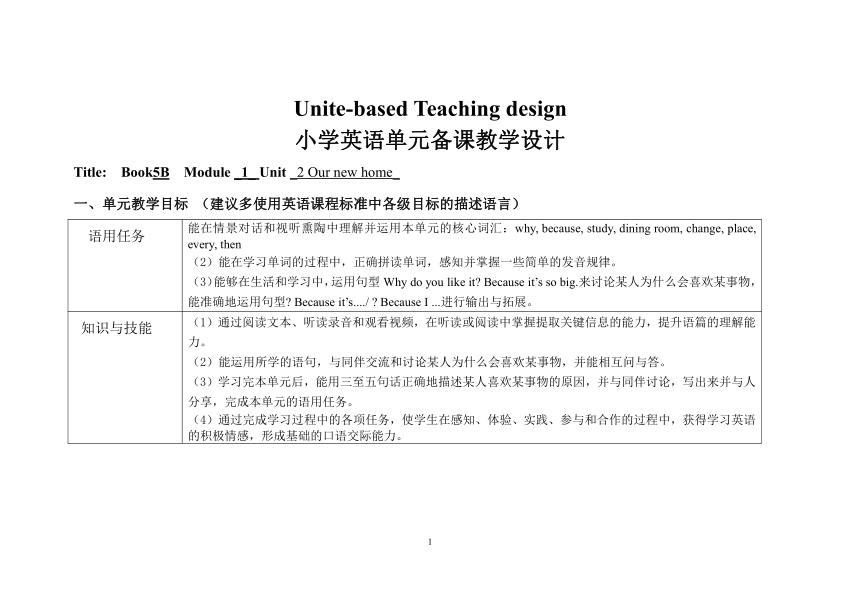 | |
| 格式 | zip | ||
| 文件大小 | 78.1KB | ||
| 资源类型 | 教案 | ||
| 版本资源 | 牛津深圳版 | ||
| 科目 | 英语 | ||
| 更新时间 | 2018-04-02 14:21:04 | ||
图片预览

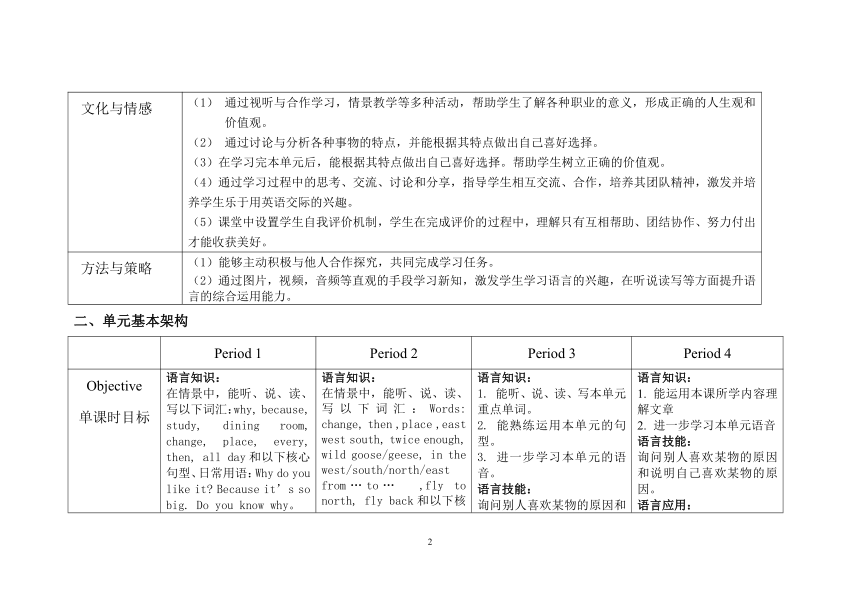
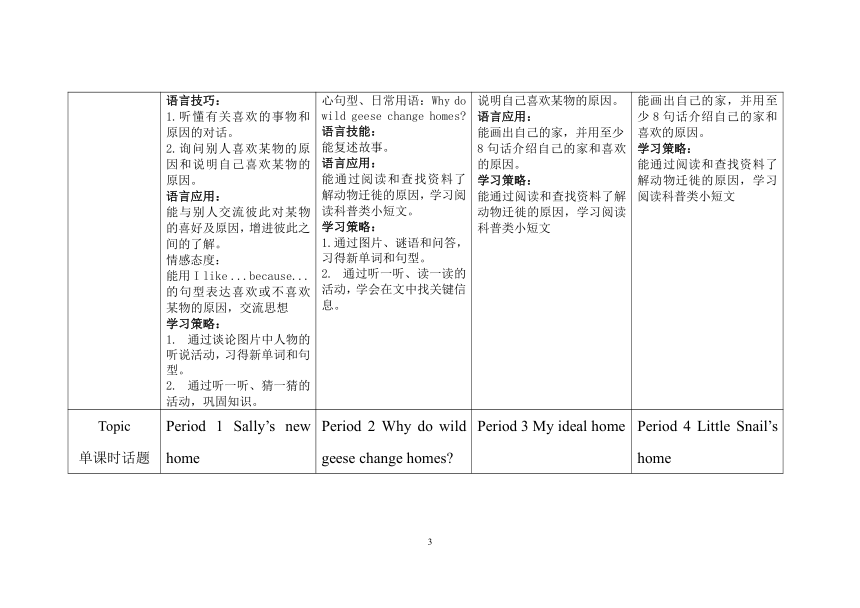
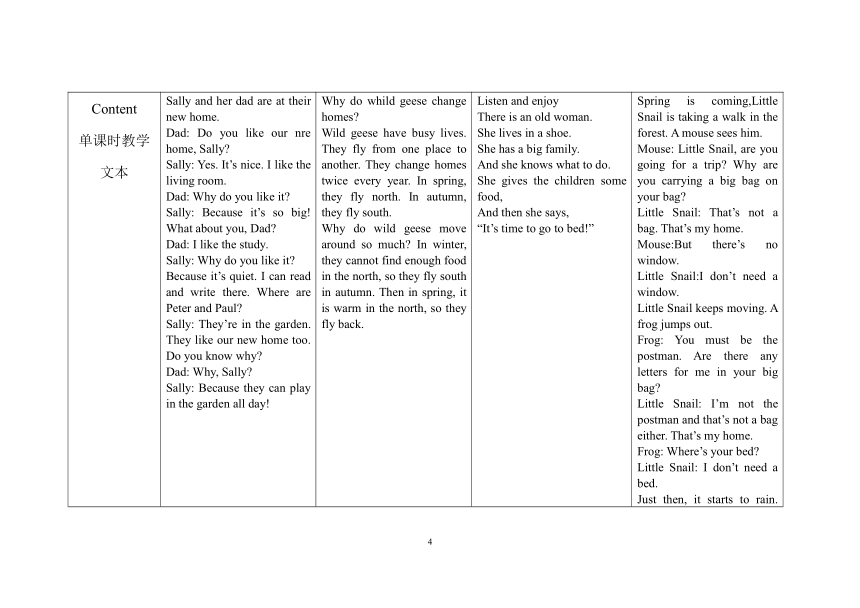
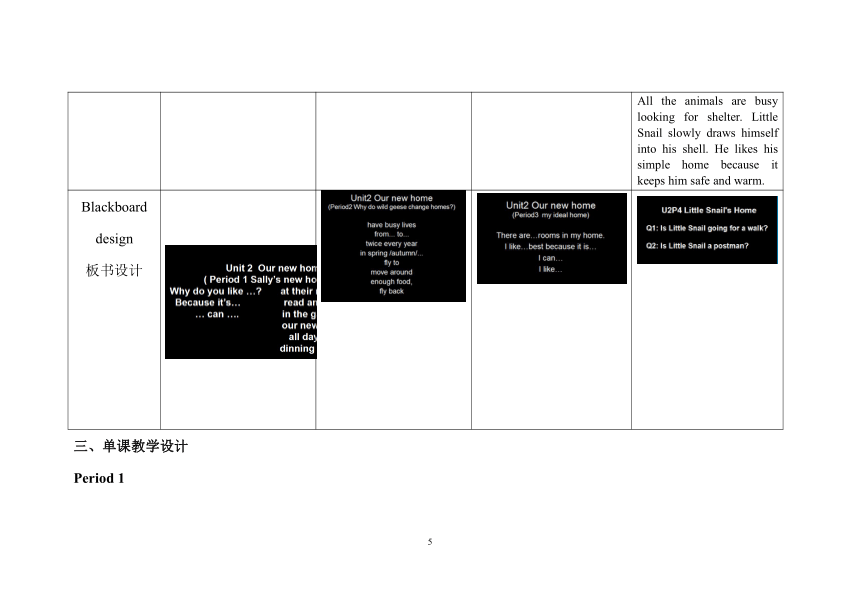
文档简介
Unite-based Teaching design
小学英语单元备课教学设计
Title: Book5B Module _1_ Unit _2 Our new home_
一、单元教学目标 (建议多使用英语课程标准中各级目标的描述语言)
语用任务
能在情景对话和视听熏陶中理解并运用本单元的核心词汇:why, because, study, dining room, change, place, every, then
(2)能在学习单词的过程中,正确拼读单词,感知并掌握一些简单的发音规律。
(3)能够在生活和学习中,运用句型Why do you like it? Because it’s so big.来讨论某人为什么会喜欢某事物,能准确地运用句型? Because it’s..../ ? Because I ...进行输出与拓展。
知识与技能
(1)通过阅读文本、听读录音和观看视频,在听读或阅读中掌握提取关键信息的能力,提升语篇的理解能力。
(2)能运用所学的语句,与同伴交流和讨论某人为什么会喜欢某事物,并能相互问与答。
(3)学习完本单元后,能用三至五句话正确地描述某人喜欢某事物的原因,并与同伴讨论,写出来并与人分享,完成本单元的语用任务。
(4)通过完成学习过程中的各项任务,使学生在感知、体验、实践、参与和合作的过程中,获得学习英语的积极情感,形成基础的口语交际能力。
文化与情感
通过视听与合作学习,情景教学等多种活动,帮助学生了解各种职业的意义,形成正确的人生观和价值观。
通过讨论与分析各种事物的特点,并能根据其特点做出自己喜好选择。
(3)在学习完本单元后,能根据其特点做出自己喜好选择。帮助学生树立正确的价值观。
(4)通过学习过程中的思考、交流、讨论和分享,指导学生相互交流、合作,培养其团队精神,激发并培养学生乐于用英语交际的兴趣。
(5)课堂中设置学生自我评价机制,学生在完成评价的过程中,理解只有互相帮助、团结协作、努力付出才能收获美好。
方法与策略
(1)能够主动积极与他人合作探究,共同完成学习任务。
(2)通过图片,视频,音频等直观的手段学习新知,激发学生学习语言的兴趣,在听说读写等方面提升语言的综合运用能力。
二、单元基本架构
Period 1
Period 2
Period 3
Period 4
Objective
单课时目标
语言知识:
在情景中,能听、说、读、写以下词汇:why, because, study, dining room, change, place, every, then, all day和以下核心句型、日常用语:Why do you like it? Because it’s so big. Do you know why。
语言技巧:
1.听懂有关喜欢的事物和原因的对话。
2.询问别人喜欢某物的原因和说明自己喜欢某物的原因。
语言应用:
能与别人交流彼此对某物的喜好及原因,增进彼此之间的了解。
情感态度:
能用I like ...because...的句型表达喜欢或不喜欢某物的原因,交流思想
学习策略:
1. 通过谈论图片中人物的听说活动,习得新单词和句型。
2. 通过听一听、猜一猜的活动,巩固知识。
语言知识:
在情景中,能听、说、读、写以下词汇:Words: change, then ,place ,east west south, twice enough, wild goose/geese, in the west/south/north/east from…to… ,fly to north, fly back和以下核心句型、日常用语:Why do wild geese change homes?
语言技能:
能复述故事。
语言应用:
能通过阅读和查找资料了解动物迁徙的原因,学习阅读科普类小短文。
学习策略:
1.通过图片、谜语和问答,习得新单词和句型。
2. 通过听一听、读一读的活动,学会在文中找关键信息。
语言知识:
1. 能听、说、读、写本单元重点单词。
2. 能熟练运用本单元的句型。
3. 进一步学习本单元的语音。
语言技能:
询问别人喜欢某物的原因和说明自己喜欢某物的原因。
语言应用:
能画出自己的家,并用至少8句话介绍自己的家和喜欢的原因。
学习策略:
能通过阅读和查找资料了解动物迁徙的原因,学习阅读科普类小短文
语言知识:
能运用本课所学内容理解文章
进一步学习本单元语音
语言技能:
询问别人喜欢某物的原因和说明自己喜欢某物的原因。
语言应用:
能画出自己的家,并用至少8句话介绍自己的家和喜欢的原因。
学习策略:
能通过阅读和查找资料了解动物迁徙的原因,学习阅读科普类小短文
Topic
单课时话题
Period 1 Sally’s new home
Period 2 Why do wild geese change homes?
Period 3 My ideal home
Period 4 Little Snail’s home
Content
单课时教学文本
Sally and her dad are at their new home.
Dad: Do you like our nre home, Sally?
Sally: Yes. It’s nice. I like the living room.
Dad: Why do you like it?
Sally: Because it’s so big! What about you, Dad?
Dad: I like the study.
Sally: Why do you like it?
Because it’s quiet. I can read and write there. Where are Peter and Paul?
Sally: They’re in the garden. They like our new home too. Do you know why?
Dad: Why, Sally?
Sally: Because they can play in the garden all day!
Why do whild geese change homes?
Wild geese have busy lives. They fly from one place to another. They change homes twice every year. In spring, they fly north. In autumn, they fly south.
Why do wild geese move around so much? In winter, they cannot find enough food in the north, so they fly south in autumn. Then in spring, it is warm in the north, so they fly back.
Listen and enjoy
There is an old woman.
She lives in a shoe.
She has a big family.
And she knows what to do.
She gives the children some food,
And then she says,
“It’s time to go to bed!”
Spring is coming,Little Snail is taking a walk in the forest. A mouse sees him.
Mouse: Little Snail, are you going for a trip? Why are you carrying a big bag on your bag?
Little Snail: That’s not a bag. That’s my home.
Mouse:But there’s no window.
Little Snail:I don’t need a window.
Little Snail keeps moving. A frog jumps out.
Frog: You must be the postman. Are there any letters for me in your big bag?
Little Snail: I’m not the postman and that’s not a bag either. That’s my home.
Frog: Where’s your bed?
Little Snail: I don’t need a bed.
Just then, it starts to rain. All the animals are busy looking for shelter. Little Snail slowly draws himself into his shell. He likes his simple home because it keeps him safe and warm.
Blackboard design
板书设计
三、单课教学设计
Period 1
Procedures
Contents
Methods
Purpose
Pre-lesson
Learn the sounds:
1 Watch the video.
Learn the sound
/з:/ ir: girl bird third
ur: nurse purse
er: her hers
/?:/ au: Laura
oor: door moor
ar: warm war
Try to read the words by phonics
视频播放
教师引导学生用已学过的因素知识拼读
通过观看视频感知ir,ur,au,oor发音,并通过观察找出视频中含以上字母组合发音的单词进行拼读,初步掌握其的发音规则。
Pre-task preparation
1. Greetings
2.What do you usually do at home?
视频播放
活跃课堂氛围,为后文讲故事埋下伏笔
While-task procedure
Learn the text:
Listen and match.
Sally and her father are talking about their new home.
What’s their favourite room and why?
Read and answer.
1) Which room do you like, Sally?
I like the living room.
Why do you like it?
Because it’s big and nice.
There’s a lot of sunshine.
Which room do you like, Dad?
I like...
Why do you like it?
Because...
3) How about Peter and Paul?
Complete and act
Dad: Do you like our_______?
Sally: Yes. It’s nice. I like the___________.
Dad: Why ______________? Sally: Because __________! And it faces______. There is a lot
of_______. I like___________. _____________, Dad?
Dad: I like the study.
Sally: _________________?
Dad: _________. I like_______.
I can_________________. Where are Peter and Paul?
Sally: They’re ___________. They like______________. Do you know why?
Dad: Why, Sally? Sally: ______________ all day!
第一遍无字幕听视频,回答问题,感知整体。
第二遍带着字幕看视频,分析Sally 和她爸爸喜欢新房子的哪里并找原因。
第三遍在教师带领下跟读文章。
第四遍学生进行角色扮演。
1.通知提问,引导学生在寻找问题的过程中整体感知文本内容,对文本有一个初步的了解。
2. 分析课文人物喜好的原因,通过细节梳理故事脉络,解决文本中重难点问题。
3.通过模仿跟读和角色扮演,为语言的输出做进一步巩固
Post-task activity
Do a survey.
Interviewer: ___________ Interviewee: ___________
Date: _________________
Theme: Favourite room(s) at home
1). What is your favourite room?
2). What is the room like?
3). What do you usually do in the room?
4). Why do you like it?
学生四人小组讨论,完成12页的表格
学生结合自己的生活实际,进行口语输出。
Assignment
Homework:
Write and say
Warm tips:
1): Think about your home.
2): Draw a mind map.
3): Write about your home.
Hi! Welcome to_________! It is__________.
There is/are __________________________in my family.
There is/are _________________________near my home.
I like the __________ because __________________.
Period 2
Procedures
Contents
Methods
Purpose
Pre-lesson
Learn the sounds:
1 Watch the video and read the chant.
2. Find out more words with “ir” “ur” “au” “oor” and blend the words.
播放视频
通过跟着视频朗读巩固几个字母组合的发音,并通过观察找出视频中含有这些字母组合的单词进行拼读,进一步掌握发音规则。
Pre-task preparation
1. Let’s talk.
Do you want to change your home?
Why or why not?
Because it’s …..
There is /are no……
It has/doesn’t have……
I like/don’t like……
I can/can’t…..
Let’s guess.
They’re black , white and gray. Their necks are long and thick.The wings are long and sharp.They live near lakes and rivers.They’re good at swimming and flying.They eat plants and insect.
What is it?
What do you know about geese?
学生小组讨论,谈论自己的家。
学生猜谜这种动物是什么。
1.谈论自己的家,是否想搬家。理由是什么?为新授内容---鸟类的迁徙,做好铺垫。
2. 猜谜引入故事,激发兴趣。
While-task procedure
1.Watch and answer.
1).How often do they change
their homes in a year?
2).Where do they fly to?
2. Read and answer.
Why do they change homes?
Why can’t wild geese find enough food in the north in winter?
3.Think over.
Are wild geese the only animal that changes homes?
Do other animals change homes?
视频播放,回答问题
朗读课文,回答问题
延伸思考,拓展问题
看图回答问题,培养观察能力。
2.读课文,回答问题。培养学生在文中找信息的能力。
思考并回答。培养发散思维能力。
Post-task activity
1.True or false.
( ) Wild geese don’t have busy lives.
( ) Wild geese can find food in the south in winter.
( ) Wild geese fly back to the north in spring.
( ) Wild geese change homes once a year. 2.Fill in the blanks.
The sun rises in the _____ and goes down in the _____.
Beijing is in the _____ of China.
Hainan is in the _____ of China.
3.Retell the story and complete the following passage.
Wild geese have ______lives. They fly one place to another. They ______homes _______ every year.
In spring, they fly _____. In autumn, they fly _____. Why do wild geese ______ around so much?
In winter, they cannot find _____ food in the north, so they fly south in autumn.
Then in spring, it is warm in the north, so they fly _____.
学生完成练习。
学生进行故事复述并填空完成课文。
1.根据课文内容判断正误。考察学习对课文的理解能力。
2.检测对词汇的运用能力。
3.复述故事。加深理解。
Assignment
Homework:
1. Introduce your friend’s favourite room(s).
2. Read and spell the new words.
Period 3
Procedures
Contents
Methods
Purpose
Pre-lesson
Learn the sound.
1. Say the chant.
2. Read and judge.
学生朗读chant,并做语音练习。
复习字母组合ir, ur, au, oor的拼读规则。
Pre-task preparation
Show a picture of beautiful home; tell the pupils it’s my ideal home. Then lead in the title.
照片展示,引入主题。
读短文回答问题,为新授内容做好铺垫。
While-task procedure
1.Revise some places in a house such as living room, bedroom, bathroom, kitchen,
Then learn two new places in a home such as study and dinning room/hall and so on.
2.Lead the differences between the new home and the old one to practice “Which room do you like? What is the room like?” with the words of the places in a home mentioned above.
照片展示并复习房间单词。
照片展示并复习重点句型。
复习关于房间的单词。
复习重点句型。
Post-task activity
1.Ask the puppils to draw their ideal home.
2.Group work. (Talk about your ideal home)
Model.
Group work.
3.Report.
学生小组讨论。
培养学生的动手能力,学科整合。
培养学生的口语交际能力和合作能力。
Assignment
Homework:
1. Read the passage “Why do wild geese change homes?” on Student’s Book page 10.
2. Retell the passage.
3. Search the information and find the relative answers to the questions. Finish the poster.
Period 4
Procedures
Contents
Methods
Purpose
Pre-lesson
Read the sounds of ir, ur, au, and oor
Blend the words with these letters
Ss give more words and blend
播放视频
复习巩固本课的语音知识
Pre-task preparation
1.Greetings
2.Warming up:
What animals do you like?
Where does... live?
口头对话
以自己喜爱的动物作为切口,谈论小动物的家。作为本课内容的铺垫。
While-task procedure
1.Listen to the story of “Little Snail’s home”
and answer the following questions:
Is the snail going for a trip?
Is the snail a postman?
2.Learn the story:
Part 1: Read by character(boy-girl)
Part 2: Read by character(in pairs)
Part 3: Read by character(the whole class)
3.Read and complete:
Little Snail___in the forest. The mouse thinks Little Snail is going for a ___. The frog thinks Little Snail is the___. They both think the shell on the snail’s back is a big bag. In fact, the shell is the Little Snail’ s home. Then it rains. All the other animals look for ___. Little Snail just draws himself into the ___ and it keeps him___ and warm.
第一遍带问题听,回答问题,感知整体。
第二遍分段学习。
第三遍在教师带领下跟读文章。
第四遍学生进行角色扮演。
根据故事内容完成填空。
1.通知提问,引导学生在寻找问题的过程中整体感知文本内容,对文本有一个初步的了解。
2. 通过细节梳理故事脉络,解决文本中重难点问题。
3.通过模仿跟读和角色扮演,为语言的输出做进一步巩固
4.通过完成填空总结梳理故事。
Post-task activity
1.Read, choose and match
2.Think and act.
练习巩固
巩固
Assignment
Make a mindmap about your favourite animal’s home.
四、阅读素养评价
A 读短文,根据短文内容,选择正确答案。
Many animals do not stay in one place. Birds, fish, and other animals move from one place to another at a certain time(特定时间段). Most of them move to find food. But some of them move to find enough space(空间). When it gets cold, many birds move to warmer places to find food. Some fish give birth(产卵) in warm water and move to cold water to feed their babies. How interesting!
( ) 1. Animals often change their homes. They don’t stay in one______.
place B. school C. supermarket
( ) 2. Most of animals move to find ______.
babies B. food C. parents
( ) 3. Some of the animals move to find ______ space.
many B. enough C. small
( ) 4. When it gets ______, many birds move to warmer places to find food.
warm B. hot C. cold
B 读短文,判断句子正(T)误(F)
I’m at my uncle’s new home with my family now. All the family members like his new home. Uncle Bob likes all the rooms because they’re all new and beautiful. Aunt May likes the bedroom because it’s beside the garden. She can hear the birds in the morning every day. Their study is big and quiet. There are many books in it. There is a big TV in the living room. My cousin Lucy likes the room best. She can watch TV in it. My grandmother likes the garden because she likes planting plants. She wants to plant a lot of flowers in the garden. I like the garden too because I can play badminton with Lucy in the garden all day.
( ) 1. I’m at my uncle’s new home with my friends now.
( ) 2. All the family members like the new home.
( ) 3. Aunt May likes the garden because it’s beside the bedroom.
( ) 4. My cousin Lucy likes the living room because she can do homework there.
( ) 5. My grandmother likes the garden because she likes planting plants.
C读短文,根据短文内容,选择正确答案。
Hi! My name is Lucy. I’m eleven years old. I am a student. This is my home. There is a living room, a kitchen, a bathroom and three bedrooms in it. The living room is big. There is a big TV on the wall. I like watching TV at night with my parents. Look! This is my bedroom. There is a nice desk in the bedroom. On the desk, there are some books and a bag. My cat is in the kitchen. It’s hungry. It would like a hot dog. Tom is my brother. He is ten. He is in the bathroom now.
( ) 1. How old is Lucy?
Eleven B. Ten C. Twelve
( ) 2. Where are the books?
In the bathroom B. In the kitchen C. On the desk
( ) 3. Who is Lucy’s brother?
Tom B. Mike C. David
( ) 4. Where is Tom now?
In the kitchen B. In the bedroom C. In the bathroom
D读对话,判断句子正(T)误(F)
Dad: Do you like our new home, Mike?
Mike: Yes, I do. It’s nice.
Dad: Why do you like it?
Mike: Because it’s near my school. How about you, Dad?
Dad: I like the study.
Mike: Why do you like it?
Dad: Because it’s big and quiet. I can read and write there.
Mike: Do you like our new home, Mum?
Mum: Yes. I like the kitchen. Because it’s big and clean. I can cook food there.
( ) 1. Mike’s family don’t like their new home.
( ) 2. Mike likes the new home because it’s near his school.
( ) 3. Mike’s father likes the dining room.
( ) 4. The study is big and quiet. Mike’s father can read and write there.
( ) 5. Mike’s mother likes the kitchen because it’s big and clean.
设计要求:
1. 建议选取的阅读内容与单元主题、单课时话题相关,根据学生的特点,为不同层次的学生选择不同的阅读材料,鼓励选取故事、对话、诗歌等不同形式的阅读材料,避免因为阅读材料太难而降低学生学习英语的兴趣;
2. 建议老师参考国外原版阅读材料、绘本等资源,语篇语言尽可能地道;
3. 在提供阅读体验的同时注重阅读习惯的培养,建议老师对阅读能力的考查设计不同类型的题型,对阅读理解类型提供做题方法和技巧的指导。
五、推荐阅读
1. 老师给孩子们推荐与主题相关的阅读材料或者影视剧作品等;
2. 孩子可以根据自己的选择在课外阅读或观赏,不做硬性要求。
小学英语单元备课教学设计
Title: Book5B Module _1_ Unit _2 Our new home_
一、单元教学目标 (建议多使用英语课程标准中各级目标的描述语言)
语用任务
能在情景对话和视听熏陶中理解并运用本单元的核心词汇:why, because, study, dining room, change, place, every, then
(2)能在学习单词的过程中,正确拼读单词,感知并掌握一些简单的发音规律。
(3)能够在生活和学习中,运用句型Why do you like it? Because it’s so big.来讨论某人为什么会喜欢某事物,能准确地运用句型? Because it’s..../ ? Because I ...进行输出与拓展。
知识与技能
(1)通过阅读文本、听读录音和观看视频,在听读或阅读中掌握提取关键信息的能力,提升语篇的理解能力。
(2)能运用所学的语句,与同伴交流和讨论某人为什么会喜欢某事物,并能相互问与答。
(3)学习完本单元后,能用三至五句话正确地描述某人喜欢某事物的原因,并与同伴讨论,写出来并与人分享,完成本单元的语用任务。
(4)通过完成学习过程中的各项任务,使学生在感知、体验、实践、参与和合作的过程中,获得学习英语的积极情感,形成基础的口语交际能力。
文化与情感
通过视听与合作学习,情景教学等多种活动,帮助学生了解各种职业的意义,形成正确的人生观和价值观。
通过讨论与分析各种事物的特点,并能根据其特点做出自己喜好选择。
(3)在学习完本单元后,能根据其特点做出自己喜好选择。帮助学生树立正确的价值观。
(4)通过学习过程中的思考、交流、讨论和分享,指导学生相互交流、合作,培养其团队精神,激发并培养学生乐于用英语交际的兴趣。
(5)课堂中设置学生自我评价机制,学生在完成评价的过程中,理解只有互相帮助、团结协作、努力付出才能收获美好。
方法与策略
(1)能够主动积极与他人合作探究,共同完成学习任务。
(2)通过图片,视频,音频等直观的手段学习新知,激发学生学习语言的兴趣,在听说读写等方面提升语言的综合运用能力。
二、单元基本架构
Period 1
Period 2
Period 3
Period 4
Objective
单课时目标
语言知识:
在情景中,能听、说、读、写以下词汇:why, because, study, dining room, change, place, every, then, all day和以下核心句型、日常用语:Why do you like it? Because it’s so big. Do you know why。
语言技巧:
1.听懂有关喜欢的事物和原因的对话。
2.询问别人喜欢某物的原因和说明自己喜欢某物的原因。
语言应用:
能与别人交流彼此对某物的喜好及原因,增进彼此之间的了解。
情感态度:
能用I like ...because...的句型表达喜欢或不喜欢某物的原因,交流思想
学习策略:
1. 通过谈论图片中人物的听说活动,习得新单词和句型。
2. 通过听一听、猜一猜的活动,巩固知识。
语言知识:
在情景中,能听、说、读、写以下词汇:Words: change, then ,place ,east west south, twice enough, wild goose/geese, in the west/south/north/east from…to… ,fly to north, fly back和以下核心句型、日常用语:Why do wild geese change homes?
语言技能:
能复述故事。
语言应用:
能通过阅读和查找资料了解动物迁徙的原因,学习阅读科普类小短文。
学习策略:
1.通过图片、谜语和问答,习得新单词和句型。
2. 通过听一听、读一读的活动,学会在文中找关键信息。
语言知识:
1. 能听、说、读、写本单元重点单词。
2. 能熟练运用本单元的句型。
3. 进一步学习本单元的语音。
语言技能:
询问别人喜欢某物的原因和说明自己喜欢某物的原因。
语言应用:
能画出自己的家,并用至少8句话介绍自己的家和喜欢的原因。
学习策略:
能通过阅读和查找资料了解动物迁徙的原因,学习阅读科普类小短文
语言知识:
能运用本课所学内容理解文章
进一步学习本单元语音
语言技能:
询问别人喜欢某物的原因和说明自己喜欢某物的原因。
语言应用:
能画出自己的家,并用至少8句话介绍自己的家和喜欢的原因。
学习策略:
能通过阅读和查找资料了解动物迁徙的原因,学习阅读科普类小短文
Topic
单课时话题
Period 1 Sally’s new home
Period 2 Why do wild geese change homes?
Period 3 My ideal home
Period 4 Little Snail’s home
Content
单课时教学文本
Sally and her dad are at their new home.
Dad: Do you like our nre home, Sally?
Sally: Yes. It’s nice. I like the living room.
Dad: Why do you like it?
Sally: Because it’s so big! What about you, Dad?
Dad: I like the study.
Sally: Why do you like it?
Because it’s quiet. I can read and write there. Where are Peter and Paul?
Sally: They’re in the garden. They like our new home too. Do you know why?
Dad: Why, Sally?
Sally: Because they can play in the garden all day!
Why do whild geese change homes?
Wild geese have busy lives. They fly from one place to another. They change homes twice every year. In spring, they fly north. In autumn, they fly south.
Why do wild geese move around so much? In winter, they cannot find enough food in the north, so they fly south in autumn. Then in spring, it is warm in the north, so they fly back.
Listen and enjoy
There is an old woman.
She lives in a shoe.
She has a big family.
And she knows what to do.
She gives the children some food,
And then she says,
“It’s time to go to bed!”
Spring is coming,Little Snail is taking a walk in the forest. A mouse sees him.
Mouse: Little Snail, are you going for a trip? Why are you carrying a big bag on your bag?
Little Snail: That’s not a bag. That’s my home.
Mouse:But there’s no window.
Little Snail:I don’t need a window.
Little Snail keeps moving. A frog jumps out.
Frog: You must be the postman. Are there any letters for me in your big bag?
Little Snail: I’m not the postman and that’s not a bag either. That’s my home.
Frog: Where’s your bed?
Little Snail: I don’t need a bed.
Just then, it starts to rain. All the animals are busy looking for shelter. Little Snail slowly draws himself into his shell. He likes his simple home because it keeps him safe and warm.
Blackboard design
板书设计
三、单课教学设计
Period 1
Procedures
Contents
Methods
Purpose
Pre-lesson
Learn the sounds:
1 Watch the video.
Learn the sound
/з:/ ir: girl bird third
ur: nurse purse
er: her hers
/?:/ au: Laura
oor: door moor
ar: warm war
Try to read the words by phonics
视频播放
教师引导学生用已学过的因素知识拼读
通过观看视频感知ir,ur,au,oor发音,并通过观察找出视频中含以上字母组合发音的单词进行拼读,初步掌握其的发音规则。
Pre-task preparation
1. Greetings
2.What do you usually do at home?
视频播放
活跃课堂氛围,为后文讲故事埋下伏笔
While-task procedure
Learn the text:
Listen and match.
Sally and her father are talking about their new home.
What’s their favourite room and why?
Read and answer.
1) Which room do you like, Sally?
I like the living room.
Why do you like it?
Because it’s big and nice.
There’s a lot of sunshine.
Which room do you like, Dad?
I like...
Why do you like it?
Because...
3) How about Peter and Paul?
Complete and act
Dad: Do you like our_______?
Sally: Yes. It’s nice. I like the___________.
Dad: Why ______________? Sally: Because __________! And it faces______. There is a lot
of_______. I like___________. _____________, Dad?
Dad: I like the study.
Sally: _________________?
Dad: _________. I like_______.
I can_________________. Where are Peter and Paul?
Sally: They’re ___________. They like______________. Do you know why?
Dad: Why, Sally? Sally: ______________ all day!
第一遍无字幕听视频,回答问题,感知整体。
第二遍带着字幕看视频,分析Sally 和她爸爸喜欢新房子的哪里并找原因。
第三遍在教师带领下跟读文章。
第四遍学生进行角色扮演。
1.通知提问,引导学生在寻找问题的过程中整体感知文本内容,对文本有一个初步的了解。
2. 分析课文人物喜好的原因,通过细节梳理故事脉络,解决文本中重难点问题。
3.通过模仿跟读和角色扮演,为语言的输出做进一步巩固
Post-task activity
Do a survey.
Interviewer: ___________ Interviewee: ___________
Date: _________________
Theme: Favourite room(s) at home
1). What is your favourite room?
2). What is the room like?
3). What do you usually do in the room?
4). Why do you like it?
学生四人小组讨论,完成12页的表格
学生结合自己的生活实际,进行口语输出。
Assignment
Homework:
Write and say
Warm tips:
1): Think about your home.
2): Draw a mind map.
3): Write about your home.
Hi! Welcome to_________! It is__________.
There is/are __________________________in my family.
There is/are _________________________near my home.
I like the __________ because __________________.
Period 2
Procedures
Contents
Methods
Purpose
Pre-lesson
Learn the sounds:
1 Watch the video and read the chant.
2. Find out more words with “ir” “ur” “au” “oor” and blend the words.
播放视频
通过跟着视频朗读巩固几个字母组合的发音,并通过观察找出视频中含有这些字母组合的单词进行拼读,进一步掌握发音规则。
Pre-task preparation
1. Let’s talk.
Do you want to change your home?
Why or why not?
Because it’s …..
There is /are no……
It has/doesn’t have……
I like/don’t like……
I can/can’t…..
Let’s guess.
They’re black , white and gray. Their necks are long and thick.The wings are long and sharp.They live near lakes and rivers.They’re good at swimming and flying.They eat plants and insect.
What is it?
What do you know about geese?
学生小组讨论,谈论自己的家。
学生猜谜这种动物是什么。
1.谈论自己的家,是否想搬家。理由是什么?为新授内容---鸟类的迁徙,做好铺垫。
2. 猜谜引入故事,激发兴趣。
While-task procedure
1.Watch and answer.
1).How often do they change
their homes in a year?
2).Where do they fly to?
2. Read and answer.
Why do they change homes?
Why can’t wild geese find enough food in the north in winter?
3.Think over.
Are wild geese the only animal that changes homes?
Do other animals change homes?
视频播放,回答问题
朗读课文,回答问题
延伸思考,拓展问题
看图回答问题,培养观察能力。
2.读课文,回答问题。培养学生在文中找信息的能力。
思考并回答。培养发散思维能力。
Post-task activity
1.True or false.
( ) Wild geese don’t have busy lives.
( ) Wild geese can find food in the south in winter.
( ) Wild geese fly back to the north in spring.
( ) Wild geese change homes once a year. 2.Fill in the blanks.
The sun rises in the _____ and goes down in the _____.
Beijing is in the _____ of China.
Hainan is in the _____ of China.
3.Retell the story and complete the following passage.
Wild geese have ______lives. They fly one place to another. They ______homes _______ every year.
In spring, they fly _____. In autumn, they fly _____. Why do wild geese ______ around so much?
In winter, they cannot find _____ food in the north, so they fly south in autumn.
Then in spring, it is warm in the north, so they fly _____.
学生完成练习。
学生进行故事复述并填空完成课文。
1.根据课文内容判断正误。考察学习对课文的理解能力。
2.检测对词汇的运用能力。
3.复述故事。加深理解。
Assignment
Homework:
1. Introduce your friend’s favourite room(s).
2. Read and spell the new words.
Period 3
Procedures
Contents
Methods
Purpose
Pre-lesson
Learn the sound.
1. Say the chant.
2. Read and judge.
学生朗读chant,并做语音练习。
复习字母组合ir, ur, au, oor的拼读规则。
Pre-task preparation
Show a picture of beautiful home; tell the pupils it’s my ideal home. Then lead in the title.
照片展示,引入主题。
读短文回答问题,为新授内容做好铺垫。
While-task procedure
1.Revise some places in a house such as living room, bedroom, bathroom, kitchen,
Then learn two new places in a home such as study and dinning room/hall and so on.
2.Lead the differences between the new home and the old one to practice “Which room do you like? What is the room like?” with the words of the places in a home mentioned above.
照片展示并复习房间单词。
照片展示并复习重点句型。
复习关于房间的单词。
复习重点句型。
Post-task activity
1.Ask the puppils to draw their ideal home.
2.Group work. (Talk about your ideal home)
Model.
Group work.
3.Report.
学生小组讨论。
培养学生的动手能力,学科整合。
培养学生的口语交际能力和合作能力。
Assignment
Homework:
1. Read the passage “Why do wild geese change homes?” on Student’s Book page 10.
2. Retell the passage.
3. Search the information and find the relative answers to the questions. Finish the poster.
Period 4
Procedures
Contents
Methods
Purpose
Pre-lesson
Read the sounds of ir, ur, au, and oor
Blend the words with these letters
Ss give more words and blend
播放视频
复习巩固本课的语音知识
Pre-task preparation
1.Greetings
2.Warming up:
What animals do you like?
Where does... live?
口头对话
以自己喜爱的动物作为切口,谈论小动物的家。作为本课内容的铺垫。
While-task procedure
1.Listen to the story of “Little Snail’s home”
and answer the following questions:
Is the snail going for a trip?
Is the snail a postman?
2.Learn the story:
Part 1: Read by character(boy-girl)
Part 2: Read by character(in pairs)
Part 3: Read by character(the whole class)
3.Read and complete:
Little Snail___in the forest. The mouse thinks Little Snail is going for a ___. The frog thinks Little Snail is the___. They both think the shell on the snail’s back is a big bag. In fact, the shell is the Little Snail’ s home. Then it rains. All the other animals look for ___. Little Snail just draws himself into the ___ and it keeps him___ and warm.
第一遍带问题听,回答问题,感知整体。
第二遍分段学习。
第三遍在教师带领下跟读文章。
第四遍学生进行角色扮演。
根据故事内容完成填空。
1.通知提问,引导学生在寻找问题的过程中整体感知文本内容,对文本有一个初步的了解。
2. 通过细节梳理故事脉络,解决文本中重难点问题。
3.通过模仿跟读和角色扮演,为语言的输出做进一步巩固
4.通过完成填空总结梳理故事。
Post-task activity
1.Read, choose and match
2.Think and act.
练习巩固
巩固
Assignment
Make a mindmap about your favourite animal’s home.
四、阅读素养评价
A 读短文,根据短文内容,选择正确答案。
Many animals do not stay in one place. Birds, fish, and other animals move from one place to another at a certain time(特定时间段). Most of them move to find food. But some of them move to find enough space(空间). When it gets cold, many birds move to warmer places to find food. Some fish give birth(产卵) in warm water and move to cold water to feed their babies. How interesting!
( ) 1. Animals often change their homes. They don’t stay in one______.
place B. school C. supermarket
( ) 2. Most of animals move to find ______.
babies B. food C. parents
( ) 3. Some of the animals move to find ______ space.
many B. enough C. small
( ) 4. When it gets ______, many birds move to warmer places to find food.
warm B. hot C. cold
B 读短文,判断句子正(T)误(F)
I’m at my uncle’s new home with my family now. All the family members like his new home. Uncle Bob likes all the rooms because they’re all new and beautiful. Aunt May likes the bedroom because it’s beside the garden. She can hear the birds in the morning every day. Their study is big and quiet. There are many books in it. There is a big TV in the living room. My cousin Lucy likes the room best. She can watch TV in it. My grandmother likes the garden because she likes planting plants. She wants to plant a lot of flowers in the garden. I like the garden too because I can play badminton with Lucy in the garden all day.
( ) 1. I’m at my uncle’s new home with my friends now.
( ) 2. All the family members like the new home.
( ) 3. Aunt May likes the garden because it’s beside the bedroom.
( ) 4. My cousin Lucy likes the living room because she can do homework there.
( ) 5. My grandmother likes the garden because she likes planting plants.
C读短文,根据短文内容,选择正确答案。
Hi! My name is Lucy. I’m eleven years old. I am a student. This is my home. There is a living room, a kitchen, a bathroom and three bedrooms in it. The living room is big. There is a big TV on the wall. I like watching TV at night with my parents. Look! This is my bedroom. There is a nice desk in the bedroom. On the desk, there are some books and a bag. My cat is in the kitchen. It’s hungry. It would like a hot dog. Tom is my brother. He is ten. He is in the bathroom now.
( ) 1. How old is Lucy?
Eleven B. Ten C. Twelve
( ) 2. Where are the books?
In the bathroom B. In the kitchen C. On the desk
( ) 3. Who is Lucy’s brother?
Tom B. Mike C. David
( ) 4. Where is Tom now?
In the kitchen B. In the bedroom C. In the bathroom
D读对话,判断句子正(T)误(F)
Dad: Do you like our new home, Mike?
Mike: Yes, I do. It’s nice.
Dad: Why do you like it?
Mike: Because it’s near my school. How about you, Dad?
Dad: I like the study.
Mike: Why do you like it?
Dad: Because it’s big and quiet. I can read and write there.
Mike: Do you like our new home, Mum?
Mum: Yes. I like the kitchen. Because it’s big and clean. I can cook food there.
( ) 1. Mike’s family don’t like their new home.
( ) 2. Mike likes the new home because it’s near his school.
( ) 3. Mike’s father likes the dining room.
( ) 4. The study is big and quiet. Mike’s father can read and write there.
( ) 5. Mike’s mother likes the kitchen because it’s big and clean.
设计要求:
1. 建议选取的阅读内容与单元主题、单课时话题相关,根据学生的特点,为不同层次的学生选择不同的阅读材料,鼓励选取故事、对话、诗歌等不同形式的阅读材料,避免因为阅读材料太难而降低学生学习英语的兴趣;
2. 建议老师参考国外原版阅读材料、绘本等资源,语篇语言尽可能地道;
3. 在提供阅读体验的同时注重阅读习惯的培养,建议老师对阅读能力的考查设计不同类型的题型,对阅读理解类型提供做题方法和技巧的指导。
五、推荐阅读
1. 老师给孩子们推荐与主题相关的阅读材料或者影视剧作品等;
2. 孩子可以根据自己的选择在课外阅读或观赏,不做硬性要求。
同课章节目录
- Module 1 Changes and differences
- Unit 1 Tidy up!
- Unit 2 Our new home
- Unit 3 In the future
- Revision 1
- Project 1
- Module 2 Work and play
- Unit 4 Reading is fun
- Unit 5 At the weekend
- Unit 6 Holidays
- Revision 2
- Project 2
- Module 3 Things we do
- Unit 7 Open Day
- Unit 8 Buying clothes
- Unit 9 Seeing the docto
- Revision 3
- Project 3
- Module 4 Things we enjoy
- Unit 10 Great inventions
- Unit 11 Chinese festivals
- Unit 12 The giant's garden
- Project 4
